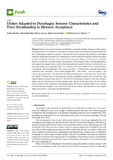Mostrar el registro sencillo del ítem
Dishes adapted to dysphagia: sensory characteristics and their relationship to hedonic acceptance
| dc.creator | Merino Antón, Gorka | es_ES |
| dc.creator | Marín Arroyo, Remedios | es_ES |
| dc.creator | Beriain Apesteguía, María José | es_ES |
| dc.creator | Ibáñez Moya, Francisco C. | es_ES |
| dc.date.accessioned | 2021-03-01T12:51:44Z | |
| dc.date.available | 2021-03-01T12:51:44Z | |
| dc.date.issued | 2021 | |
| dc.identifier.issn | 2304-8158 (Electronic) | |
| dc.identifier.uri | https://hdl.handle.net/2454/39270 | |
| dc.description.abstract | Dishes whose texture has been modified for dysphagia undergo changes in other sensory characteristics as well. Therefore, it is necessary to identify these characteristics in adapted dishes and their relationship to hedonic acceptance. In the present work, the sensory characteristics of five dishes adapted to dysphagia associated with cerebral palsy were investigated using the check-all-that-apply method. A hedonic evaluation with a panel of non-dysphagic judges was performed to relate the degree of acceptance with the sensory characteristics of the adapted dishes. The identification of the original non-adapted dish as well as the relationship between the hedonic evaluation by nondysphagic judges and dysphagic judges were explored. The main attributes of the dishes adapted to dysphagia were “homogeneity” and “easy-to-swallow”. Attributes that increased the hedonic evaluation were “flavorful”, “flavor of the original dish”, “soft texture”, “easy-to-swallow”, and “odor of the original dish”. The attributes that decreased the hedonic evaluation were “thick mash” and “bland”. The fish dish was the only one correctly identified more than 62.5% of the time. The adapted dishes received scores above 4.7 out of 9.0 in the hedonic evaluation. The most accepted dishes were the chicken stew and the chickpea stew. Except for the pasta dish, the test yielded similar results to those obtained with dysphagic judges. The texture-modified dishes were correctly characterized and accepted. This study shows that all the sensory characteristics of the adapted dishes are crucial for acceptance and identification. | en |
| dc.description.sponsorship | This study has been partially financed by the European Regional Development Fund through the 2014–2020 FEDER Operational Program of Navarre and by Navarre Government through the Program “Ayudas para realizar proyectos de I+D—Convocatoria 2017” (PEP E-14/000107-01). | en |
| dc.format.mimetype | application/pdf | en |
| dc.language.iso | eng | en |
| dc.publisher | MDPI | en |
| dc.relation.ispartof | Foods 2021, 10, 480 | en |
| dc.rights | © 2021 by the authors. Licensee MDPI, Basel, Switzerland. This article is an open access article distributed under the terms and conditions of the Creative Commons Attribution (CC BY) license | en |
| dc.rights.uri | http://creativecommons.org/licenses/by/4.0/ | |
| dc.subject | Adapted dish | en |
| dc.subject | Texture-modified | en |
| dc.subject | Check-all-that-apply | en |
| dc.subject | Acceptability | en |
| dc.subject | Sensory characteristics | en |
| dc.subject | Dish identification | en |
| dc.title | Dishes adapted to dysphagia: sensory characteristics and their relationship to hedonic acceptance | en |
| dc.type | Artículo / Artikulua | es |
| dc.type | info:eu-repo/semantics/article | en |
| dc.contributor.department | Institute on Innovation and Sustainable Development in Food Chain - ISFOOD | en |
| dc.rights.accessRights | Acceso abierto / Sarbide irekia | es |
| dc.rights.accessRights | info:eu-repo/semantics/openAccess | en |
| dc.identifier.doi | 10.3390/foods10020480 | |
| dc.relation.publisherversion | https://doi.org/10.3390/foods10020480 | |
| dc.type.version | Versión publicada / Argitaratu den bertsioa | es |
| dc.type.version | info:eu-repo/semantics/publishedVersion | en |
| dc.contributor.funder | Gobierno de Navarra / Nafarroako Gobernua | es |



